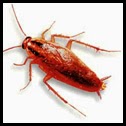There are roughly five common pestiferous species of cockroach in North America, and each species varies somewhat in preference to environment and appetite. The German cockroach, for example, is as comfortable indoors as it is outdoors and will eat just about anything, while the smoky brown cockroach prefers to live outdoors and is considered primarily a vegetarian.
Below we will provide for you a clear picture of the possible cockroach that is infesting your home, tell you a little bit about its behavior, and then offer pest control suggestions specific to that species of cockroach.
The American cockroach prefers moisture and warmth, which explains why it is so commonly found in boats, bathrooms, basements, and sewers. The American cockroach is one of the larger species of pestiferous roaches in the U.S., but luckily for you it is less common in homes and apartments. However, if you've identified the American cockroach as your problem pest, perhaps the best way to get rid of the American cockroach is to cut off access to your home and reduce the amount of residual moisture in your home. Caulking cracks and crevices in your foundation as well as in your baseboards and walls in the first floor of your home is paramount.
The German cockroach can thrive in just about any environment and is less reliant upon moisture than other roaches. For these reasons, the German cockroach has become the most common pest in the American household, far beyond any other cockroach in North America. The German cockroach has one weakness and that is its preference for warm air (like that of its native North Africa). Heating vents and furnaces are some of their most common hiding places. Sanitary standards are, of course, one of the most effective ways to get rid of German cockroaches, but simply putting out roach baits that use boric acid as their active ingredient will usually take care of the problem.
The brown banded cockroach, like the German cockroach, prefers warmer, drier climates, thus making them a problem in the upper floors and attics of your home. The brown banded cockroach is a notorious eater of clothes, fabrics, glue, and other starchy substances, which is why you'll often find clusters of them in shelf spaces and warm, upstairs closets--especially bedrooms. Follow this up by vacuuming your rooms thoroughly, using a crevice attachment to suck roaches and their eggs from their hiding spots.
The Oriental cockroach is less common than either the German or brown banded cockroach and prefers very wet environments. You will often find the Oriental cockroach feeding on decaying food, in garbage containers, and anywhere else food has been dropped. These particular roaches are considered the perfect vector for food borne illnesses because of their appreciation for rotting food or leftover scraps, rather than starchy foods and sugars. Because of the Oriental cockroach's affinity for sewers, drains, refrigerators, basements, cellars, and any other cool, moist environment, your best option for comprehensive roach control is to keep your home warm and dry. You should replace all garbage containers with sealable bins, take out the trash regularly, and avoid leaving scraps of food or compost heaps near your home.
The smoky brown cockroach is primarily an outdoors roach that will wander indoors only if there is a food source. The smoky brown cockroach prefers plant matter as its primary food source, so you will often see these roaches in gardens and greenhouses--rarely in areas where humans tend to dwell. Because of the smoky brown cockroach's love of rotting fruits and vegetables, it's a good idea to begin a roach control regiment by cleaning away any organic matter from doorways, windowsills, and edges of buildings. Ground level walls and foundations should be inspected and caulk should be used to seal any cracks that are observed




